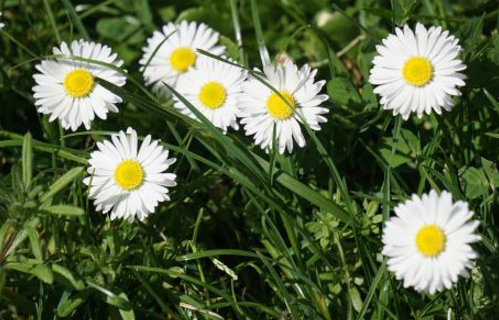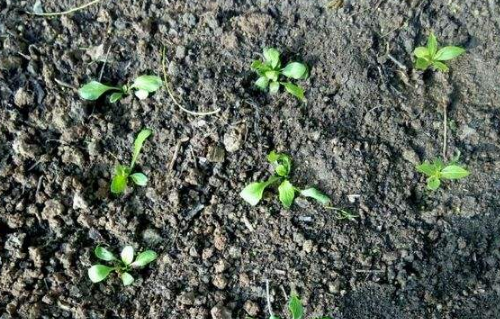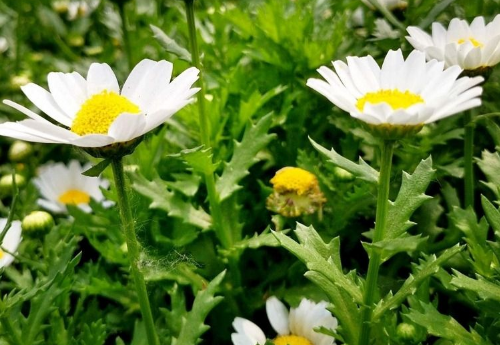How to breed daisies
1. Light
Daisies like sunshine and are resistant to semi-shade, especially during flowering. Plenty of sunshine will make flowers bloom more brightly, but be careful to avoid strong light in summer.
two。 Moisture content
Daisies have a great demand for water in the budding period, so the soil is moist. When the seedlings begin to grow, they should be watered less. Generally, they should be watered again when the soil is dry.

3. Temperature
Daisies like to be warm, and the suitable temperature for growth is 20-25 ℃. High temperature should be avoided in summer and protected in semi-shade. In winter, the temperature should be kept above 5 ℃ in order to grow healthily.
4. Fertilizer
The healthy growth of daisies not only needs nutrients in the soil, but also requires us to often topdressing fertilizer, you can choose some compound fertilizer, pay attention to the use of diluted fertilizer, so as not to burn plant roots with too high concentration.
Culture methods of daisies
The cultivation method of daisies: daisies are often sown in autumn for 2-year-old cultivation, while spring sowing in alpine areas is used for annual cultivation. Sow and propagate in the open seedbed in the middle of August or the beginning of September. After sowing, it is appropriate to use Reed curtain to shade, not covered with film. All the seedlings come out and the curtains are removed. When two or three leaves grow, they will be planted for the first time, with bare roots without lodging soil. When the seedlings produce 3-4 true leaves, the lateral roots can be promoted by transplanting with soil blocks twice. To prevent overgrowth. Daisies can survive the winter and are afraid of severe frost and air-drying. The thickness of the mat and the removal time will be controlled flexibly according to the growth of the seedlings and the cold and warm weather, so as to prevent overgrowth and effectively control the florescence. After one or two transplants in autumn, the flower bed can be directly planted when you see flowers in spring. For those who have not been transplanted by inverted border after dividing seedlings in autumn, they should be planted or listed in the flower bed or out of the nursery after the border with sufficient base fertilizer is preserved and formed in spring. When planting, apply rotten leaf fertilizer or stable fertilizer as base fertilizer, plant distance 15 cm. After planting, it should be watered every 7 to 10 days. Thin fecal water was applied every 2 to 3 weeks until flowering.
During the growing period, daisies like to have plenty of sunshine and are not tolerant to shade. After the daisies are sown in autumn, if there is no seedling transplant, the seedlings can be raised and separated at the end of October, with a little persistent soil in the roots, and then grab a handful of humus-rich and slightly sticky moist and fertile soil prepared in advance. One or two seedlings are clutched into a lump in the center of the loam, hoarded in turn into the sunny bed, spray moisturizing, to promote the whisker root to flourish, the plant is small and strong, and it is not easy to wilt directly in the flower bed or on the market in the coming spring.
Viewing and application
Wei Chrysanthemum raise seedlings in autumn and winter, the plant is petite, green and lovely, it blossoms in spring, it is a rare chrysanthemum flower, it also feels fresh. It is usually planted in flower beds or potted balconies, walkways and other places to watch. The leaves of daisies are spoon-shaped, rosette-shaped, dense, short and emerald in color. Draw a scape from the leaves, one scape and one flower, arranged wrongly, the appearance is simple, the flowers are petite and exquisite, and the colors are harmonious.
If you can watch carefully, the ball-shaped head, the central cluster of yellow tubular flowers, surrounded by colorful tongue-shaped flowers, commonly known as petals. The colors are white, light red, crimson and so on, which match with a cluster of tongue-shaped leaves to form a small pattern. Blooming in early spring, full of vitality, with a gentleman's demeanor and naive elegant demeanor, deeply loved by the Italians, and designated it as the national flower. The flower words of daisies: happiness forever.
Culture methods of daisies the efficacy and function of daisies
Daisies are small, varied and colorful, so many people like to breed them at home. Next, I will introduce the breeding methods of daisies and the efficacy and function of daisies.
Culture methods of daisies
1. Light regulation: daisies also like sunlight, including in the growing period and flowering period. Sufficient light can promote plant growth, green leaves and increase the number of flowers.
2, temperature control: sex likes cold, cool and humid, cold-resistant but not heat-resistant, the most suitable temperature is 18-22 ℃, daisies can blossom normally, when the temperature is lower than 10 ℃, the growth is relatively slow, if the temperature is higher than 25 ℃, the flower stem will elongate, the growth potential and flowering will decline.
3. Water and fertilizer management: daisies like fertile soil and apply fertilizer every 7-10 days. Flower fertilizer of 20-10-20 and 14-0-14 can be used, or compound fertilizer can be applied or irrigated in water with a concentration of 200-250ppm. Sufficient water and fertilizer are given in the growing season to grow luxuriantly and prolong the flowering period.
4. Cultivation and management: daisies are more resistant to transplantation, which can make them have multiple roots and do not need plant shape pruning and topping to control flowering. After one or two transplants in autumn, flower beds can be directly planted in spring when they see flowers. For those who have not been transplanted by inverted border after dividing seedlings in autumn, it is appropriate to plant in the flower bed or go out of the nursery to list in spring after the border with sufficient base fertilizer is preserved and formed.
5. Diseases and insect pests: the main diseases of daisies are seedling sudden disease, gray mildew, brown spot, anthracnose, downy mildew (chlorothalonil 800 times, Jiaxianling 1000-1500 times), aphids and so on.
Efficacy and function of daisies
1. Medicinal efficacy
Daisies, also known as dried chrysanthemum and white chrysanthemum, have high medicinal value. It also has volatile oils, amino acids and a variety of trace elements. Among them, the content of brass is 32% to 61% higher than that of other chrysanthemums, and the content of tin is eight to 50 times higher than other chrysanthemums.
Zhang Lixiang, an agronomist, wrote in his book the Book of tonifying Agriculture: "White chrysanthemum is sweet and warm, and it is most beneficial to take it for a long time. Plant one or two plants in each place, take its flowers, you can reduce the tea by half, tea bitter cold and bitter chrysanthemum soak together.
2. Ornamental function
The leaves of daisies are spoon-shaped, rosette-shaped, dense, short and emerald in color. Extract scape from leaves, scape one flower, staggered arrangement, simple appearance, petite and exquisite flowers, harmonious color. Extract scape from leaves, scape one flower, staggered arrangement, simple appearance, petite and exquisite flowers, harmonious color. Blooming in early spring, full of vitality, with a gentleman's demeanor and naive elegant demeanor.
3. Horticultural function
Daisies have strong growth potential and are easy to cultivate. Daisy pedicel is of moderate height, neat flowers, bright and clean colors, can be used as potted plants to beautify the courtyard balcony, can also be used as garden ornamental, potted plants, flower borders, cut flowers and so on.
With long flowering period and strong cold tolerance, it is the first choice for ground cover flowers in early spring. Daisies, as ground cover flowers in street green space, have strong charm and can be planted with calendula, pansy, rhododendron, red leaf Berberis and so on.
4. Whitening effect
Daisy is a natural beauty product, whitening is its most important effect. There are a lot of essential oils and pyrethrins in the flowers of this plant. After extracting them, they can be made into a variety of cosmetics. It has the effect of removing melanin and softening epidermal cells. Regular consumption can make the skin more and more white and attractive.
5. Purify the air
Daisies are an ideal choice for greening the environment, and their ornamental value is very high. after putting them indoors, they can make the indoor environment fresh and pleasant, and daisies can absorb a large number of harmful substances in the air when they enter photosynthesis. to convert them into oxygen that is good for human health. It has obvious effect on purifying the environment.
The above is for you to introduce the breeding methods of daisies, as well as the efficacy and role of daisies, hope to help you, more household knowledge, please pay attention.
- Prev

Nursing methods for sowing daisies
1. Keep the temperature about 20 ℃ after sowing, keep the soil moist, avoid strong light, and germinate and grow after about a week. Keep moist after sprouting, give appropriate amount of light, and pay attention to shade in summer. two。 When the root is inserted into the medium to absorb nutrients for the growth of its cotyledons.
- Next

Propagation methods of daisies
1. Seed propagation is generally sown from August to September in the south and mostly in spring in the north. Generally, the seeds are sown evenly, covered with fine soil, then watered thoroughly and kept at a temperature of about 28 ℃. New buds can germinate in about 10 days. two。 Ramet propagation can usually dig up the old stubble chrysanthemum cauliflower in the middle and late March.
Related
- Fuxing push coffee new agricultural production and marketing class: lack of small-scale processing plants
- Jujube rice field leisure farm deep ploughing Yilan for five years to create a space for organic food and play
- Nongyu Farm-A trial of organic papaya for brave women with advanced technology
- Four points for attention in the prevention and control of diseases and insect pests of edible fungi
- How to add nutrient solution to Edible Fungi
- Is there any good way to control edible fungus mites?
- Open Inoculation Technology of Edible Fungi
- Is there any clever way to use fertilizer for edible fungus in winter?
- What agents are used to kill the pathogens of edible fungi in the mushroom shed?
- Rapid drying of Edible Fungi

